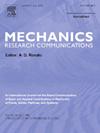Micro-scale shear testing for localized constitutive characterization of Al-Steel resistance spot weld under large deformation
IF 2.3
4区 工程技术
Q3 MECHANICS
引用次数: 0
Abstract
This study presents a methodology for characterizing local constitutive properties in Al-Steel resistance spot weld through micro-scale shear testing, focusing on capturing localized mechanical behavior under large deformation. Although conventional methods such as hardness testing and nano-indentation can capture these gradients to some extent, they are limited in directly measuring the full local stress–strain response, especially under large deformation. While micro-scale tensile testing has been used for localized property evaluation, strain localization severely limits the measurable deformation range, restricting its applicability in characterizing hardening behavior at large strains. To overcome these limitations, micro-scale shear tests combined with micro-Digital Image Correlation (μDIC) were employed, enabling stress-strain characterization at significantly larger deformations. Due to the highly localized nature of the analysis, strain field irregularities arise from the limited number of grains within the region of interest. This study introduces a μDIC data processing method to mitigate these effects for constitutive modeling. Furthermore, shear testing provides access to strain regimes beyond the limits of tensile tests, reducing uncertainties in hardening modeling under large deformations. The results reveal distinct hardening behaviors across different weld regions that could not be captured only by tensile testing.
大变形下铝钢电阻点焊局部本构特性的微尺度剪切试验
本研究提出了一种通过微尺度剪切试验表征铝钢电阻点焊局部本构性能的方法,重点是捕捉大变形下的局部力学行为。虽然硬度测试和纳米压痕等传统方法可以在一定程度上捕获这些梯度,但它们在直接测量完整的局部应力-应变响应方面受到限制,特别是在大变形下。虽然微尺度拉伸试验已被用于局部化性能评价,但应变局部化严重限制了可测量的变形范围,限制了其在大应变下表征硬化行为的适用性。为了克服这些限制,采用微尺度剪切试验结合微数字图像相关(μDIC),实现了更大变形下的应力-应变表征。由于分析的高度局域化性质,应变场的不规则性源于感兴趣区域内有限数量的晶粒。本研究引入了一种μDIC数据处理方法来减轻本构建模的这些影响。此外,剪切测试提供了超出拉伸测试极限的应变状态,减少了大变形下硬化建模的不确定性。结果显示,不同焊接区域的硬化行为不同,仅通过拉伸试验无法捕获。
本文章由计算机程序翻译,如有差异,请以英文原文为准。
求助全文
约1分钟内获得全文
求助全文
来源期刊
CiteScore
4.10
自引率
4.20%
发文量
114
审稿时长
9 months
期刊介绍:
Mechanics Research Communications publishes, as rapidly as possible, peer-reviewed manuscripts of high standards but restricted length. It aims to provide:
• a fast means of communication
• an exchange of ideas among workers in mechanics
• an effective method of bringing new results quickly to the public
• an informal vehicle for the discussion
• of ideas that may still be in the formative stages
The field of Mechanics will be understood to encompass the behavior of continua, fluids, solids, particles and their mixtures. Submissions must contain a strong, novel contribution to the field of mechanics, and ideally should be focused on current issues in the field involving theoretical, experimental and/or applied research, preferably within the broad expertise encompassed by the Board of Associate Editors. Deviations from these areas should be discussed in advance with the Editor-in-Chief.

 求助内容:
求助内容: 应助结果提醒方式:
应助结果提醒方式:


